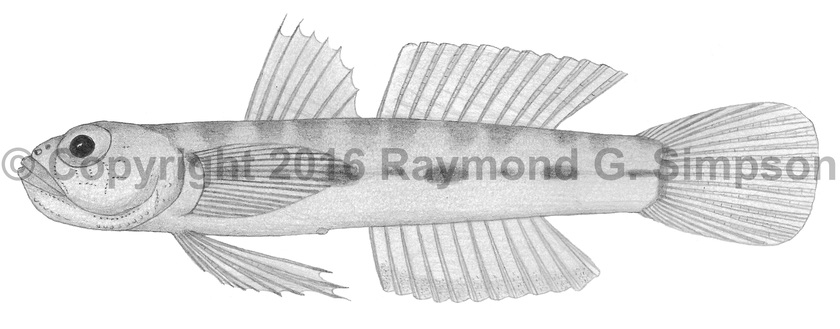
Common Name
Platform Goby
Year Described
Hastings & Findley, 2015
Identification
Dorsal Fin: VII, 11-12
Anal Fin: 11-12
Pectoral Fin: 19
Caudal Fin: 17 segmented rays
Vertebrae: 11+16= 27 (total)
Body stout and robust. Eye relatively large. Dorsal fin with anterior two spines not elongate and last two spines more spaced than the first five. Pelvic fin rays branched except for the last which is slightly longer and unbranched. Pelvic fins not fused. Two anal-fin pterygiophores anterior to the first haemal spine. Papillae rows 5i and 5s are connected as a single row. Cephalic lateralis pores absent. Body scaled posterior to pectoral base in a wedge shape (34-37 rows), with extensive cycloid scales anteriorly. Belly unscaled. No basicaudal scales.
Color
Body in preservative with no life color evident. Pigmentation appears to be a series of lateral (yellow?) blotches on the side and several saddles along the dorsum. The caudal peduncle and fin also appear to have a blotch. First dorsal with a blotch between the first two spines. Second dorsal with lines marked by melanophores. Distal part of anal fin heavily speckled. Pelvic fin densely speckled. Whole body with dense melanophores that fade on the belly.
Size
Maximum size to 26.4mm SL.
Habitat
Known from relatively deep water (54-110m). Habitat undescribed.
Range
Known from five specimens from off South Carolina, U.S.A and in the eastern Gulf of Mexico.
References
Hastings, P. A., & L.T. Findley. 2015. Chriolepis prolata, a new species of Atlantic goby (Teleostei: Gobiidae) from the North American continental shelf. Zootaxa. 3904(4): 589-595.
Tornabene, L., J.L. Van Tassell, R.G. Gilmore, D.R. Robertson, F. Young, & C.C. Baldwin. 2016. Molecular phylogeny, analysis of character evolution, and submersible collections enable a new classification of a diverse group of gobies (Teleostei: Gobiidae: Nes subgroup), including nine new species and four new genera. Zoological Journal of the Linnean Society.
Other Notes
Tornabene et al. (2016) erected Pinnichthys for four species of Caribbean gobies. It is diagnosed by meristic, osteological, and body pore characters noted above.